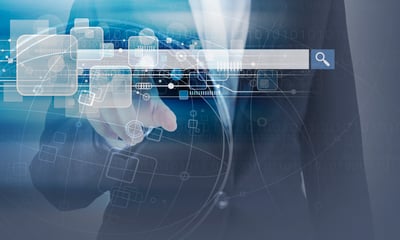June 26, 2019
 by Stephen Jeske / June 26, 2019
by Stephen Jeske / June 26, 2019

If you're struggling to rank pages, despite your best keyword optimization efforts, it's time to change how you view content.
Search engines, rank content according to how efficiently it can solve a searchers problem. Behind every search, there is an intention that Google, in particular, seeks to satisfy.
This post looks at the four states of SERP (search engine results page) intent, the way they relate to different types of user intent, and how to examine SERP features to better understand user intent – all to create a solid SEO strategy.
The change from keywords to intent started back in the fall of 2013 when Google released its Hummingbird update. Prior to that time, search was driven primarily by matching keywords to text on a page, or keyword stuffing.
User intent, also known as search intent or keyword intent, refers to the reason and goal of a user's query on a search engine. For example, a person might want to learn more about a topic, find a nearby place, or buy products.
The introduction of Hummingbird and RankBrain changed all that, and the search engine has vastly improved its ability to map user intent profiles. It’s getting better at understanding how a web page solves the problem that lies behind search intent.
Search engine optimization (SEO) has dramatically changed. The move away from keywords toward intent means that optimizing a page for a specific keyword provides diminishing returns. As Google’s John Mueller explains on this Webmaster hangout, their relevance algorithms continue to evolve along with the web itself.
Continuing to focus on keywords in this era of semantic search is a critical misstep. Understanding user intent is the first step to creating a better user experience based on a topical intent-segmented content strategy.
User intent is challenging to discern from just a few words of text. Before examining the different type of user intent, let’s look at the four states of intent and how they apply to understand the objective behind search queries.
Human language is surprisingly full of ambiguity, which your audience has no problem decoding. Computers, on the other hand, struggle to resolve these uncertainties. User behavior can be fickle indeed.
Let's take a look at the word "bat," which could refer to a number of entities including animal, cigarette company (British American Tobacco), a piece of sports equipment (baseball bat), a cryptocurrency token (Basic Attention Token), or a silver coin issued by the Royal Canadian Mint, or a Halloween bat figure.

Who knew one word could mean so much? That is the challenge faced by search engines 5+ billion times a day.
Ranking for this type of keyword phrase may prove to be disappointing. If the term to which your page refers doesn't match, click-through rates and corresponding traffic will be negligible.
Fractured intent is different than ambiguity in that the phrase used in the search only means one thing. However, there are many possible reasons for someone to use that specific phrase. This is where the disconnect occurs.
Take, for example, the term "SEO software." There could be several motives for using this term. Perhaps a searcher is getting started in SEO and looking for background information on software used in this profession. Maybe they've progressed through the buyer journey and are looking for comparisons to find the best SEO software. Or they might be interested in a specific brand of software but forgot the name.
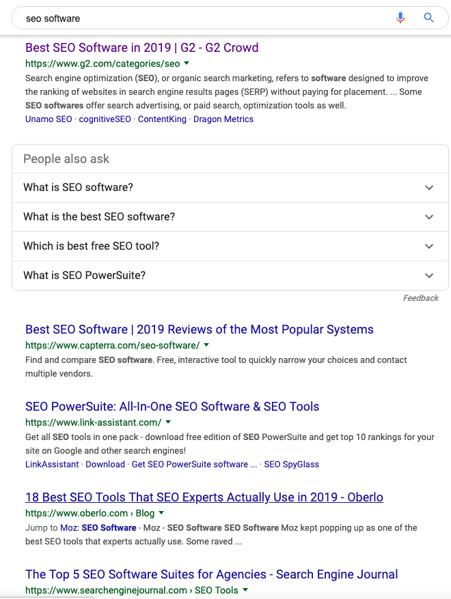
As is the case with topically ambiguous phrases, SERPs displaying a high degree of intent fracture can prove challenging. Searchers entering the phrase for which you rank may have a different intent than provided with your content. Once more, the resulting click-through rates will be disappointing.
Looking at the SERP for the term “SEO software,” it appears that Google prefers comparison-type pages. That’s the favored intent with 7 out of 10 search results matching that description.
Don’t make the mistake of thinking all you need to do to rank for this term is create a better comparison page. Although Google reveals that comparative intent is the type it prefers for this result, sites ranking for this term have a lot of depth content-wise.
A quick search reveals that G2.com, in first place for this term, has 800+ pages discussing SEO software. You can be sure that these pages are interlinked, creating a web of well-connected content that positions themselves as experts on this topic.
Of the four states of user intent, explicit intent is the easiest to explain. Search phrases exhibiting explicit intent are usually long-tail queries as in the case of "tickets for how to train your dragon 3" or "buy Japanese koi near me." In both examples, it's clear that those searching the web have an intention that is transactional.
Sometimes explicit intent can be evident in short phrases like “cluster headaches” or “best digital marketing software.” In the former, there's just one intent, and that is informational. In the latter, the comparative intent is obviously the only one.
Out of all four user intents, explicit intent is the easiest to satisfy. The desire of the searcher is apparent, simplifying the creation of content.
Now that you understand the four states of user intent, let’s dig into the various types you’re sure to come across in your searches.
Local intent phrases typically incorporate a physical location within the search term to restrict results to a given geographical area. Search engine results pages usually feature a local pack showing three listings of local businesses related to the query. Below this, the organic entries all display a strong local component.
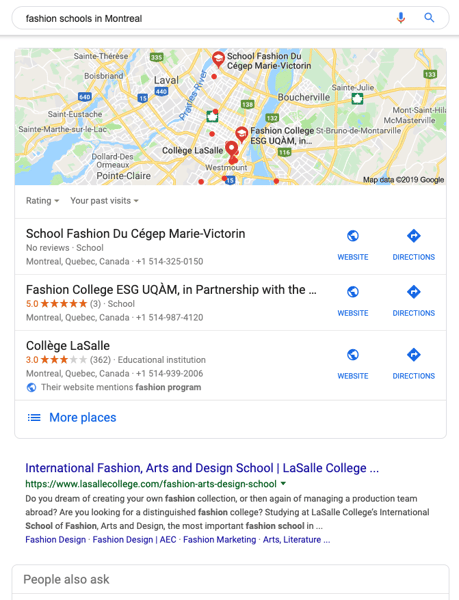
“What is a quadratic equation” is a good example of a search term exhibiting informational intent. Search features often found in the results include a knowledge panel, related questions, and videos.

This phrase also exhibits explicit intent as there is no comparative, local, transactional, or navigational component to the search. No doubt, researchers using this phrase are merely seeking information on the definition of a quadratic equation.
In the previous section on different states of intent, "best digital marketing software" was associated with explicit intent because the purpose behind the term is precise. The phrase also displays comparative intent because the word "best" describes a comparison. Words like "best," "worst," "least expensive," “top,” and “most expensive” also imply comparative intent.
Due to its exactness, phrases with comparative intent are almost always explicit.
"Buy chocolate" shows transactional intent that happens to be fractured. The term "buy" implies a transaction, but a question remains as to whether the sale will take place online or in a physical location. In addition to the sponsored listings, ads, and organic results, there is a local pack listing of chocolatiers near me; just in case I want to visit!
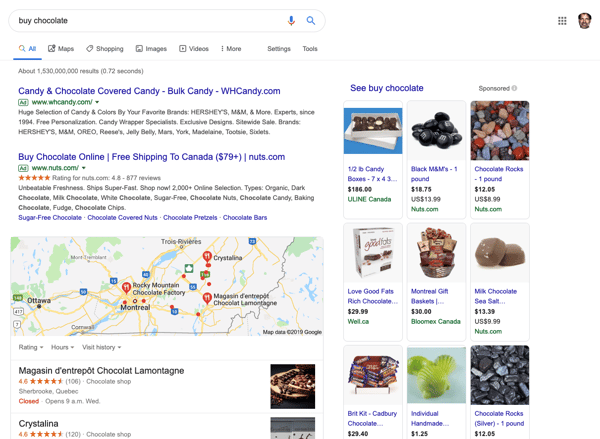
Search terms displaying navigational intent have a brand name in the query and typically signify a searcher's plan to visit a specific site. Here's a search for one particular box of chocolate, called "Le Livre" from the French chocolatier Debauve & Gallais. 7 out of 10 organic listings on the first page of the SERP point to the company’s website. The first listing is the product page.
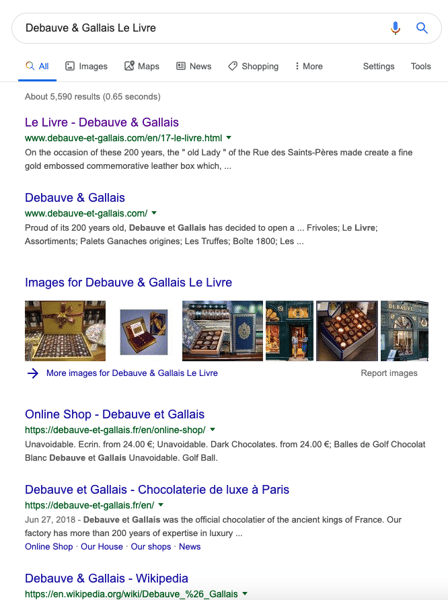
It’s tempting to jump to conclusions about a specific type of intent, based on the search term alone. However, looking at the SERPs provides greater insight into the state of that intent and Google’s interpretation.
Take the term "bat" that we used earlier as an example. It's evident to people in the cryptocurrency business that BAT refers to Basic Attention Token. With a monthly search volume of 673,000, it's tempting to go all in and target that keyword phrase.
But before you commit all your resources, and then some, take a look at the SERP. Out of those hundreds of thousands of searches, only a fraction is interested in Basic Attention Tokens. The rest are looking for information on the animal, the cigarette company, and baseball.
|
TIP: In order to stay ahead of your competitors, you need the right strategy AND the right tools. SEO software helps you better understand search intent to identify the best strategy for your business moving forward. |
Search results for ambiguous terms are always challenging. Not only are you competing against different pages, but you’re also competing against various interests. In these cases, the expectation of success needs to be modified.
Search term results that exhibit heavy intent fraction can be equally challenging. Although the definition of the term is clear, the reason behind the search is not. In this scenario, you may want to consider targeting the intent that seems to be most favored in the SERP.
Favored intent, as mentioned previously, can appear deceptively easy. In this situation, it's critical to further research the SERP entries to determine the amount of supporting content they have published, how frequently they post, how often they update content, and how it's linked.
Explicit intent is the easiest to detect in the SERP due to the nature of long-tail keywords. They make clear the purpose behind the search, facilitating the creation of content.
SERP features can be very useful in determining the intent. But, for the most part, the ones like featured snippets and knowledge graph aren't unique to the intent. The exceptions are local pack, which always appears for search terms exhibiting local intent, and shopping pack, which frequently appears where there is a transactional intent.
Remember, determining intent isn’t the end of your job. The SERPs are continually evolving as a result of newly created competitive content and updates to Google’s search algorithm. Those changes may significantly impact the ability of your page to rank. Therefore, it's good practice to regularly review the SERP to detect any changes.
Intent can change over time. Competitors can improve the quality of their content and create supporting content. New sites targeting your topic can enter the SERP as well. It pays to be proactive and conduct regular reviews of the SERPs for those topics that matter most to your business.
Want to read more related content? Brush up on how SEO works for a refresher!
Stephen Jeske is a content strategist at MarketMuse, the AI platform that lets marketing teams build high-quality content at scale. Craft content that improves organic search rankings, drives expertise in your industry and impacts revenue.
Search offers a far richer experience than ever.
 by Stephen Jeske
by Stephen Jeske
In a perfect world, every piece of content would rank well.
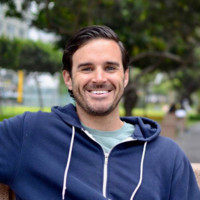 by Quincy Smith
by Quincy Smith
Over the years, on-page SEO practices, for the most part, have remained the same.
 by Manick Bhan
by Manick Bhan
Search offers a far richer experience than ever.
 by Stephen Jeske
by Stephen Jeske
In a perfect world, every piece of content would rank well.
 by Quincy Smith
by Quincy Smith
